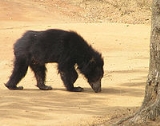
Sri Lankan Sloth Bear
Encyclopedia
The Sri Lankan Sloth Bear (Melursus ursinus inornatus) is a subspecies of the Sloth Bear
. It is found mainly in lowland dry forests in the Island of Sri Lanka
.
The Sri Lankan Sloth Bear is omnivorous. It feeds on nuts, berries, and roots, as well as carrion and meat. One of its main staples is insects, which it removes from rotting stumps and trees with its long, hairless snout and its naked lips. It rarely kills animals. This bear
also likes honey
.
Yala National Park
is a famous place to sight these mammals in Sri Lanka
.
, this bear is called Walaha in Sinhala Language and Karadi in Tamil Language
. Both terms simply translates to 'bear' in English
. Sloth bear is the only bear
species found in Sri Lanka
.
Sloth Bear
The sloth bear , also known as the labiated bear, is a nocturnal insectivorous species of bear found wild within the Indian subcontinent. The sloth bear evolved from ancestral brown bears during the Pleistocene and shares features found in insect-eating mammals through convergent evolution...
. It is found mainly in lowland dry forests in the Island of Sri Lanka
Sri Lanka
Sri Lanka, officially the Democratic Socialist Republic of Sri Lanka is a country off the southern coast of the Indian subcontinent. Known until 1972 as Ceylon , Sri Lanka is an island surrounded by the Indian Ocean, the Gulf of Mannar and the Palk Strait, and lies in the vicinity of India and the...
.
The Sri Lankan Sloth Bear is omnivorous. It feeds on nuts, berries, and roots, as well as carrion and meat. One of its main staples is insects, which it removes from rotting stumps and trees with its long, hairless snout and its naked lips. It rarely kills animals. This bear
Bear
Bears are mammals of the family Ursidae. Bears are classified as caniforms, or doglike carnivorans, with the pinnipeds being their closest living relatives. Although there are only eight living species of bear, they are widespread, appearing in a wide variety of habitats throughout the Northern...
also likes honey
Honey
Honey is a sweet food made by bees using nectar from flowers. The variety produced by honey bees is the one most commonly referred to and is the type of honey collected by beekeepers and consumed by humans...
.
Yala National Park
Yala National Park
Yala National Park is the most visited and second largest national park in Sri Lanka. Actually it consists of five blocks, two of which are now open to the public; and also adjoining parks. The blocks have individual names also, like Ruhuna National Park for the block 1 and Kumana National Park or...
is a famous place to sight these mammals in Sri Lanka
Sri Lanka
Sri Lanka, officially the Democratic Socialist Republic of Sri Lanka is a country off the southern coast of the Indian subcontinent. Known until 1972 as Ceylon , Sri Lanka is an island surrounded by the Indian Ocean, the Gulf of Mannar and the Palk Strait, and lies in the vicinity of India and the...
.
Local Names
In its native habitat in Sri LankaSri Lanka
Sri Lanka, officially the Democratic Socialist Republic of Sri Lanka is a country off the southern coast of the Indian subcontinent. Known until 1972 as Ceylon , Sri Lanka is an island surrounded by the Indian Ocean, the Gulf of Mannar and the Palk Strait, and lies in the vicinity of India and the...
, this bear is called Walaha in Sinhala Language and Karadi in Tamil Language
Tamil language
Tamil is a Dravidian language spoken predominantly by Tamil people of the Indian subcontinent. It has official status in the Indian state of Tamil Nadu and in the Indian union territory of Pondicherry. Tamil is also an official language of Sri Lanka and Singapore...
. Both terms simply translates to 'bear' in English
English language
English is a West Germanic language that arose in the Anglo-Saxon kingdoms of England and spread into what was to become south-east Scotland under the influence of the Anglian medieval kingdom of Northumbria...
. Sloth bear is the only bear
Bear
Bears are mammals of the family Ursidae. Bears are classified as caniforms, or doglike carnivorans, with the pinnipeds being their closest living relatives. Although there are only eight living species of bear, they are widespread, appearing in a wide variety of habitats throughout the Northern...
species found in Sri Lanka
Sri Lanka
Sri Lanka, officially the Democratic Socialist Republic of Sri Lanka is a country off the southern coast of the Indian subcontinent. Known until 1972 as Ceylon , Sri Lanka is an island surrounded by the Indian Ocean, the Gulf of Mannar and the Palk Strait, and lies in the vicinity of India and the...
.

